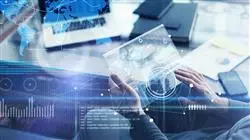University certificate
The world's largest faculty of information technology”
Description
With the best developed distance learning systems, this MBA will allow you to learn in a contextual way, learning the practical skills that you need"
This intensive specialization program is aimed at those interested in attaining a higher level of knowledge of Corporate Technical Data Science Management. Its teaching program is unique for its careful selection of technologies, including the most recently incorporated and in demand in the business world. In addition, the incorporation of specific modules for the improvement of business vision and the management of multidisciplinary teams, makes this program different and capable of covering a large part of the educational needs of any professional who wishes to position themselves as a reference in the theoretical and practical knowledge of the latest technologies.

In today's rapidly changing world, the proliferation of new technologies is a constant. Currently, we are accustomed to cutting-edge tools, platforms or technologies that are becoming obsolete with reduced applicability in the business environment.
Similarly, it is only natural that emerging or non-existent technologies in niche markets become trends in more general areas.
Without any doubt, this is an unstoppable and constantly evolving process, the maximum exponent of the current technological revolution, which forces IT professionals to specialise on a permanent basis.
In view of this situation, this MBA in Corporate Technical Data Science Management is offered as a comprehensive program that includes the most advanced and demanded technologies in the business environment.
Therefore, in an exercise of synthesis, from both a technical and business perspective, a set of subjects that are not usually covered by general educational programs has been selected, with the aim of providing students with the necessary technological knowledge to address multiple current technological problems through the use of the most appropriate and advanced techniques.
As such, the combination of both purely technical and business subjects, make this Professional Master's Degree a cutting-edge specialization especially oriented to professionals who seek to learn the most currently widespread technologies, or a higher level of knowledge of these.
The main objective is to enable students to apply the knowledge acquired in this course to the real world, in a work environment that reproduces the conditions that may be encountered in the future, in a rigorous and realistic manner.
As it is a 100% online program, students will not have to give up personal or professional obligations. Upon completion of the program, students will have updated their knowledge and will be in possession of an incredibly prestigious degree that will allow them to advance both personally and professionally.
An intensive professional growth program that will allow you to intervene in a sector with a growing demand for professionals”
This Professional master’s degree in Corporate Technical Data Science Management contains the most complete and up-to-date program on the market. The most important features include:
- Practical cases presented by experts in Advanced IT Technologies
- The graphic, schematic and eminently practical contents with which it is conceived gather scientific and practical information on those disciplines that are indispensable for professional practice
- Practical exercises where the self-assessment process can be carried out to improve learning
- Its special emphasis on innovative methodologies
- Theoretical lessons, questions to the expert, debate forums on controversial topics, and individual reflection assignments
- Content that is accessible from any fixed or portable device with an Internet connection
A high-quality program that will allow students to advance quickly and steadily in knowledge acquisition, with the scientific rigor of a global quality teaching"
The program’s teaching staff includes professionals from the sector who contribute their work experience to this training program, as well as renowned specialists from leading societies and prestigious universities.
The multimedia content, developed with the latest educational technology, will provide the professional with situated and contextual learning, i.e., a simulated environment that will provide immersive education programmed to learn in real situations.
This program is designed around Problem-Based Learning, whereby the professional must try to solve the different professional practice situations that arise during the course. For this purpose, students will be assisted by an innovative interactive video system created by renowned and experienced experts.
A complete and cutting-edge program that will allow you to progressively and completely acquire the knowledge you need to work in this sector"

Comprehensive yet focused; this program will provide you with the specific knowledge IT professionals need to compete among the best in the sector"
Syllabus
The syllabus has been designed based on educational efficiency, carefully selecting the contents to offer a comprehensive course, which includes all the fields of study that are essential to achieve real knowledge of the subject. Including the latest updates and aspects of the field. Therefore, the syllabus consists of modules that offer a broad perspective of.
Corporate Technical Data Science Management From first module, students will see their knowledge expanding, which will enable them to develop professionally, knowing that they can count on the support of a team of experts.
All the subjects and areas of knowledge have been compiled in a complete and absolutely up-to-date syllabus, in order to bring the student to the highest theoretical and practical level"
Module 1. The Main Information Management Systems
1.1. ERP and CRM
1.1.1. ERP
1.1.2. CRM
1.1.3. Differences between ERP and CRM Selling Point
1.1.4. Business Success
1.2. ERP
1.2.1. ERP
1.2.2. Types of ERPs
1.2.3. Development of an ERP Implementation Project
1.2.4. ERP Resource Optimizer
1.2.5. Architecture of an ERP System
1.3. Information Provided by the ERP
1.3.1. Information Provided by the ERP
1.3.2. Advantages and Disadvantages
1.3.3. The Information
1.4. ERP Systems
1.4.1. Current ERP Systems and Tools
1.4.2. Decision Making
1.4.3. Day-to-Day with ERP
1.5. CRM: The Implementation Project
1.5.1. The CRM The Implementation Project
1.5.2. The CRM as a Commercial Tool
1.5.3. Strategies for the Information System
1.6. CRM: Customer Loyalty
1.6.1. Starting Point
1.6.2. Sales or Loyalty
1.6.3. Factors for Success in our Loyalty System
1.6.4. Multi-Channel Strategies
1.6.5. Design of Loyalty Actions
1.6.6. E-Loyalty
1.7. CRM: Communication Campaigns
1.7.1. Communication Actions and Plans
1.7.2. Importance of the Informed Customer
1.7.3. Listening to the Client
1.8. CRM: Dissatisfaction Prevention
1.8.1. Customer Cancellations
1.8.2. Detecting Errors in Time
1.8.3. Improvement Processes
1.8.4. Recovery of the Dissatisfied Customer
1.9. CRM: Special Communication Actions
1.9.1. Objectives and Planning of a Company Event
1.9.2. Design and Realization of the Event
1.9.3. Actions from the Department
1.9.4. Result Analysis
1.10. Relational Marketing
1.10.1. Implantation. Errors
1.10.2. Methodology, Segmentation and Processes
1.10.3. Performance, According to the Department
1.10.4. CRM Tools
Module 2. Data Types and Life Cycle
2.1. Statistics
2.1.1. Statistics: Descriptive Statistics, Statistical Inferences
2.1.2. Population, Sample, Individual
2.1.3. Variables: Definition, Measurement Scales
2.2. Types of Data Statistics
2.2.1. According to Type
2.2.1.1. Quantitative: Continuous Data and Discrete Data
2.2.1.2. Qualitative: Binomial Data, Nominal Data and Ordinal Data
2.2.2. According to their Shape
2.2.2.1. Numeric
2.2.2.2. Text:
2.2.2.3. Logical
2.2.3. According to its Source
2.2.3.1. Primary
2.2.3.2. Secondary
2.3. Life Cycle of Data
2.3.1. Stages of the Cycle
2.3.2. Milestones of the Cycle
2.3.3. FAIR Principles
2.4. Initial Stages of the Cycle
2.4.1. Definition of Goals
2.4.2. Determination of Resource Requirements
2.4.3. Gantt Chart
2.4.4. Data Structure
2.5. Data Collection
2.5.1. Methodology of Data Collection
2.5.2. Data Collection Tools
2.5.3. Data Collection Channels
2.6. Data Cleaning
2.6.1. Phases of Data Cleansing
2.6.2. Data Quality
2.6.3. Data Manipulation (with R)
2.7. Data Analysis, Interpretation and Evaluation of Results
2.7.1. Statistical Measures
2.7.2. Relationship Indexes
2.7.3. Data Mining
2.8. Data Warehouse (Datawarehouse)
2.8.1. Elements that Comprise it
2.8.2. Design
2.8.3. Aspects to Consider
2.9. Data Availability
2.9.1. Access
2.9.2. Uses
2.9.3. Security
2.10. Data Protection Law
2.10.1. Good Practices
2.10.2. Other Regulatory Aspects
Module 3. Number Machine Learning
3.1. Knowledge in Databases
3.1.1. Data Pre-Processing
3.1.2. Analysis
3.1.3. Interpretation and Evaluation of the Results
3.2. Machine Learning
3.2.1. Supervised and Unsupervised Learning
3.2.2. Reinforcement Learning
3.2.3. Semi-Supervised Learning: Other Learning Models
3.3. Classification
3.3.1. Decision Trees and Rule-Based Learning
3.3.2. Support Vector Machines (SVM) and K-Nearest Neighbor (KNN) Algorithms.
3.3.3. Metrics for Sorting Algorithms
3.4. Regression
3.4.1. Linear and Logistic Regression
3.4.2. Non-Linear Regression Models
3.4.3. Time Series Analysis
3.4.4. Metrics for Regression Algorithms
3.5. Clustering
3.5.1. Hierarchical Grouping
3.5.2. Partitional Grouping
3.5.3. Metrics for Clustering Algorithms
3.6. Association Rules
3.6.1. Measures of Interest
3.6.2. Rule Extraction Methods
3.6.3. Metrics for Association Rule Algorithms
3.7. Multiclassifiers
3.7.1. “Bootstrap Aggregation" or "Bagging"
3.7.2. “Random “Forests” Algorithm
3.7.3. “Boosting” Algorithm
3.8. Probabilistic Reasoning Models
3.8.1. Probabilistic reasoning
3.8.2. Bayesian Networks or Belief Networks
3.8.3. “Hidden Markov Models”
3.9. Multilayer Perceptron
3.9.1. Neural Network:
3.9.2. Machine Learning with Neural Networks
3.9.3. Gradient Descent, Backpropagation and Activation Functions
3.9.4. Implementation of an Artificial Neural Network
3.10 Deep Learning
3.10.1. Deep Neural Networks. Introduction
3.10.2. Convolutional Networks
3.10.3. Sequence Modelling
3.10.4. Tensorflow and Pytorch
Module 4. Web Analytics
4.1. Web Analytics
4.1.1. Introduction
4.1.2. Evolution of Web Analytics
4.1.3. Analysis Process
4.2. Google Analytics
4.2.1. Google Analytics
4.2.2. Use
4.2.3. Objectives
4.3. Hits. Interactions with the Website
4.3.1. Basic Metrics
4.3.2. KPI (Key Performance Indicators)
4.3.3. Adequate Conversion Rates
4.4. Frequent Dimensions
4.4.1. Source
4.4.2. Medium
4.4.3. Keyword
4.4.4. Campaign
4.4.5. Personalized Labelling
4.5. Setting up Google Analytics
4.5.1. Installation. Creating the Account
4.5.2. Versions of the Tool: UA/GA4
4.5.3. Tracking Label
4.5.4. Conversion Objectives
4.6. Organization of Google Analytics
4.6.1. Account
4.6.2. Property
4.6.3. View
4.7. Google Analytics Reports
4.7.1. In Real Time
4.7.2. Audience
4.7.3. Acquisition
4.7.4. Behavior
4.7.5. Conversions
4.7.6. E-Commerce
4.8. Google Analytics Advanced Reports
4.8.1. Personalized Reports
4.8.2. Panels
4.8.3. APIs
4.9. Filters and Segments
4.9.1. Filter
4.9.2. Segment
4.9.3. Types of Segments: Predefined/Customized
4.9.4. Remarketing Lists
4.10. Digital Analytics Plan
4.10.1. Measurement
4.10.2. Implementation in the Technological Environment
4.10.3. Conclusions
Module 5. Scalable and Reliable Mass Data Usage Systems
5.1. Scalability, Reliability and Maintainability
5.1.1. Scales
5.1.2. Reliability
5.1.3. Maintainability
5.2. Data Models
5.2.1. Evolution of Data Models
5.2.2. Comparison of Relational Model with Document-Based NoSQL Model
5.2.3. Network Model
5.3. Data Storage and Retrieval Engines
5.3.1. Structured Log Storage
5.3.2. Storage in Segment Tables
5.3.3. Trees B
5.4. Services, Message Passing and Data Encoding Formats
5.4.1. Data Flow in REST Services
5.4.2. Data Flow in Message Passing
5.4.3. Message Sending Formats
5.5. Replication
5.5.1. CAP Theorem
5.5.2. Consistency Models
5.5.3. Models of Replication Based on Leader and Follower Concepts
5.6. Distributed Transactions
5.6.1. Atomic Operations
5.6.2. Distributed Transactions from Different Approaches Calvin, Spanner
5.6.3. Serializability
5.7. Partitions
5.7.1. Types of Partitions
5.7.2. Indexes in Partitions
5.7.3. Partition Rebalancing
5.8. Batch Processing
5.8.1. Batch Processing
5.8.2. MapReduce
5.8.3. Post-MapReduce Approaches
5.9. Data Stream Processing
5.9.1. Messaging Systems
5.9.2. Persistence of Data Flows
5.9.3. Uses and Operations with Data Flows
5.10. Case Uses. Twitter, Facebook, Uber
5.10.1. Twitter: The Use of Caches
5.10.2. Facebook: Non-Relational Models
5.10.3. Uber: Different Models for Different Purposes
Module 6. System Administration for Distributed Deployments
6.1. Classic Administration. The Monolithic Model
6.1.1. Classical Applications. The Monolithic Model
6.1.2. System Requirements for Monolithic Applications
6.1.3. The Administration of Monolithic Systems
6.1.4. Automation
6.2. Distributed Applications. The Microservice
6.2.1. Distributed Computing Paradigm
6.2.2. Microservices-Based Models
6.2.3. System Requirements for Distributed Models
6.2.4. Monolithic Applications vs. Distributed Applications
6.3. Tools for Resource Exploitation
6.3.1. “Iron” Management
6.3.2. Virtualization
6.3.3. Emulation
6.3.4. Paravirtualization
6.4. IaaS, PaaS and SaaS Models
6.4.1. LaaS Model
6.4.2. PaaS Model
6.4.3. SaaS Model
6.4.4. Design Patterns
6.5. Containerization
6.5.1. Virtualization with Cogroups
6.5.2. Containers
6.5.3. From Application to Container
6.5.4. Container Orchestration
6.6. Clustering
6.6.1. High Performance and High Availability
6.6.2. High Availability Models
6.6.3. Cluster as SaaS Platform
6.6.4. Cluster Securitization
6.7. Cloud Computing
6.7.1. Clusters vs Clouds
6.7.2. Types of Clouds
6.7.3. Cloud Service Models
6.7.4. Oversubscription
6.8. Monitoring and Testing
6.8.1. Types of Monitoring
6.8.2. Visualization
6.8.3. Infrastructure Tests
6.8.4. Chaos Engineering
6.9. Study Case: Kubernetes
6.9.1. Structure
6.9.2. Administration.
6.9.3. Deployment of Services
6.9.4. Development of Services for K8S
6.10. Study Case: OpenStack
6.10.1. Structure
6.10.2. Administration
6.10.3. Deployment
6.10.4. Development of Services for OpenStack
Module 7. Internet of Things
7.1. Internet of Things (IoT)
7.1.1. The Internet of the Future
7.1.2. Internet of Things and Industrial Internet of Things
7.1.3. The Industrial Internet Consortium
7.2. Architecture of Reference
7.2.1. The Architecture of Reference
7.2.2. Layers and Components
7.3. IoT Devices
7.3.1. Classification
7.3.2. Components
7.3.3. Sensors and Actuators
7.4. Communication Protocols
7.4.1. Classification
7.4.2. OSI Model
7.4.3. Technologies
7.5. IoT and IIoT platforms
7.5.1. The IoT Platform
7.5.2. General Purpose Cloud Platforms
7.5.3. Industrial Platforms
7.5.4. Open Code Platforms
7.6. Data Management on IoT Platforms
7.6.1. Management Mechanisms
7.6.2. Open Data
7.6.3. Exchange of Data
7.6.4. Data Visualization
7.7. IoT Security
7.7.1. Security Requirements
7.7.2. Security Areas
7.7.3. Security Strategies
7.7.4. IIoT Security
7.8. IoT Systems Application Areas
7.8.1. Intelligent Cities
7.8.2. Health and Fitness
7.8.3. Smart Home
7.8.4. Other Applications
7.9. Application of IIoT to Different Industrial Sectors
7.9.1. Fabrication
7.9.2. Transport
7.9.3. Energy
7.9.4. Agriculture and Livestock
7.9.5. Other Sectors
7.10. Integration of IIoT in the Industry 4.0 Model
7.10.1. IoRT (Internet of Robotics Things)
7.10.2. 3D Additive Manufacturing
7.10.3. Big Data Analytics
Module 8. Project Management and Agile Methodologies
8.1. Project Management
8.1.1. The Project
8.1.2. Phases of a Project
8.1.3. Project Management
8.2. PMI Methodology for Project Management
8.2.1. PMI (Project Management Institute)
8.2.2. PMBOK
8.2.3. Difference between Project, Program and Project Portfolio
8.2.4. Evolution of Organizations Working with Projects
8.2.5. Process Assets in Organizations
8.3. PMI Methodology for Project Management: Process
8.3.1. Groups of Processes
8.3.2. Knowledge Areas
8.3.3. Process Matrix
8.4. Agile Methodologies for Project Management
8.4.1. VUCA Context (Volatility, Uncertainty, Complexity and Ambiguity)
8.4.2. Agile Values
8.4.3. Principles of the Agile Manifesto
8.5. Agile SCRUM Framework for Project Management
8.5.1. Scrum
8.5.2. The Pillars of the Scrum Methodology
8.5.3. The Values in Scrum
8.6. Agile SCRUM Framework for Project Management Process
8.6.1. The Scrum Process
8.6.2. Typified Roles in a Scrum Process
8.6.3. The Ceremonies of Scrum
8.7. Agile SCRUM Framework for Project Management Artifacts
8.7.1. Artefacts in the Scrum Process
8.7.2. The Scrum Team
8.7.3. Metrics for Evaluating the Performance of a Scrum Team
8.8. Agile KANBAN Framework for Project Management. Kanban Method
8.8.1. Kanban
8.8.2. Benefits of Kanban
8.8.3. Kanban Method Components
8.9. Agile KANBAN Framework for Project Management. Kanban Method Practices
8.9.1. The Values of Kanban
8.9.2. Principles of the Kanban Method
8.9.3. General Practices of the Kanban Method
8.9.4. Metrics for Kanban Performance Evaluation
8.10. Comparison: PMI, SCRUM y KANBAN
8.10.1. PMI – SCRUM
8.10.2. PMI – KANBAN
8.10.3. SCRUM – KANBAN
Module 9. Communication, Leadership and Team Management
9.1. Organizational Development in Business
9.1.1. Climate, Culture and Organizational Development in the Company
9.1.2. Human Capital Management
9.2. Direction Models Decision Making
9.2.1. Paradigm Shift in Management Models
9.2.2. Management Process of the Technology Company
9.2.3. Decision-Making. Planning Instruments
9.3. Leadership Delegation and Empowerment
9.3.1. Leadership
9.3.2. Delegation and Empowerment
9.3.3. Performance Evaluation
9.4. Leadership Knowledge and Talent Management
9.4.1. Talent Management in the Company
9.4.2. Engagement Management in the Company
9.4.3. Improving Communication in the Company
9.5. Coaching Applied to Business
9.5.1. Executive Coaching
9.5.2. Team Coaching
9.6. Mentoring Applied to Business
9.6.1. Mentor Profile
9.6.2. The 4 Processes of a Mentoring Program
9.6.3. Tools and Techniques in a Mentoring Process
9.6.4. Benefits of Mentoring in the Business Environment
9.7. Team Management I. Interpersonal Relations
9.7.1. Interpersonal Relationships
9.7.1.1. Relational Styles: Focuses
9.7.1.2. Effective Meetings and Agreements in Difficult Situations
9.8. Team Management II. The Conflicts
9.8.1. The Conflicts
9.8.2. Preventing, Addressing and Resolving Conflict
9.8.2.1. Strategies to Prevent Conflict
9.8.2.2. Conflict Management. Basic Principles
9.8.2.3. Conflict Resolution Strategies
9.8.3. Stress and Work Motivation
9.9. Team Management III. Negotiation
9.9.1. Negotiation at the Managerial Level in Technology Companies
9.9.2. Styles of Negotiation
9.9.3. Negotiation Phases
9.9.3.1. Barriers to Overcome in Negotiations
9.10. Team Management IV. Negotiation Techniques
9.10.1. Negotiation Techniques and Strategies
9.10.1.1. Strategies and Main Types of Negotiation
9.10.1.2. Negotiation Tactics and Practical Issues
9.10.2. The Figure of the Negotiating Subject
Module 10. Leadership, Ethics and Social Responsibility in Companies
10.1. Globalization and Governance
10.1.1. Governance and Corporate Governance
10.1.2. The Fundamentals of Corporate Governance in Companies
10.1.3. The Role of the Board of Directors in the Corporate Governance Framework
10.2. Leadership
10.2.1. Leadership A Conceptual Approach
10.2.2. Leadership in Companies
10.2.3. The Importance of Leaders in Business Management
10.3. Cross Cultural Management
10.3.1. Cross Cultural Management Concept
10.3.2. Contributions to Knowledge of National Cultures
10.3.3. Diversity Management
10.4. Management and Leadership Development
10.4.1. Concept of Management Development
10.4.2. Concept of Leadership
10.4.3. Leadership Theories
10.4.4. Leadership Styles
10.4.5. Intelligence in Leadership
10.4.6. The Challenges of Today's Leader
10.5. Business Ethics
10.5.1. Ethics and Morality
10.5.2. Business Ethics
10.5.3. Leadership and Ethics in Companies
10.6. Sustainability
10.6.1. Sustainability and Sustainable Development
10.6.2. The 2030 Agenda
10.6.3. Sustainable Companies
10.7. Corporate Social Responsibility
10.7.1. International Dimensions of Corporate Social Responsibility
10.7.2. Implementing Corporate Social Responsibility
10.7.3. The Impact and Measurement of Corporate Social Responsibility
10.8. Responsible Management Systems and Tools
10.8.1. CSR: Corporate Social Responsibility
10.8.2. Essential Aspects for Implementing a Responsible Management Strategy
10.8.3. Steps for the Implementation of a Corporate Social Responsibility Management System
10.8.4. CSR Tools and Standards
10.9. Multinationals and Human Rights
10.9.1. Globalization, Multinational Companies and Human Rights
10.9.2. Multinational Corporations and International Law
10.9.3. Legal Instruments for Multinationals in the Area of Human Rights
10.10. Legal Environment and Corporate Governance
10.10.1. International Rules on Importation and Exportation
10.10.2. Intellectual and Industrial Property
10.10.3. International Labor Law
Module 11. People and Talent Management
11.1. Strategic People Management
11.1.1. Strategic Human Resources Management
11.1.2. Strategic People Management
11.2. Human Resources Management by Competencies
11.2.1. Analysis of the Potential
11.2.2. Remuneration Policy
11.2.3. Career/Succession Planning
11.3. Performance Evaluation and Performance Management
11.3.1. Performance Management
11.3.2. Performance Management: Objectives and Process
11.4. Innovation in Talent and People Management
11.4.1. Strategic Talent Management Models
11.4.2. Talent Identification, Training and Development
11.4.3. Loyalty and Retention
11.4.4. Proactivity and Innovation
11.5. Motivation
11.5.1. The Nature of Motivation
11.5.2. Expectations Theory
11.5.3. Needs Theory
11.5.4. Motivation and Financial Compensation
11.6. Developing High Performance Teams
11.6.1. High-Performance Teams: Self-Managed Teams
11.6.2. Methodologies for the Management of High Performance Self-Managed Teams
11.7. Change Management
11.7.1. Change Management
11.7.2. Type of Change Management Processes
11.7.3. Stages or Phases in the Change Management Process
11.8. Negotiation and Conflict Management
11.8.1. Negotiation
11.8.2. Conflict Management
11.8.3. Crisis Management
11.9. Executive Communication
11.9.1. Internal and External Communication in the Corporate Environment
11.9.2. Communication Departments
11.9.3. The Person in Charge of Communication of the Company The Profile of the Dircom
11.10. Productivity, Attraction, Retention and Activation of Talent
11.10.1. Productivity
11.10.2. Talent Attraction and Retention Levers
Module 12. Economic and Financial Management
12.1. Economic Environment
12.1.1. Macroeconomic Environment and the National Financial System
12.1.2. Financial Institutions
12.1.3. Financial Markets
12.1.4. Financial Assets
12.1.5. Other Financial Sector Entities
12.2. Executive Accounting
12.2.1. Basic Concepts
12.2.2. The Company's Assets
12.2.3. The Company's Liabilities
12.2.4. The Company's Net Worth
12.2.5. The Income Statement
12.3. Information Systems and Business Intelligence
12.3.1. Fundamentals and Classification
12.3.2. Cost Allocation Phases and Methods
12.3.3. Choice of Cost Center and Impact
12.4. Budget and Management Control
12.4.1. The Budget Model
12.4.2. The Capital Budget
12.4.3. The Operating Budget
12.4.5. Treasury Budget
12.4.6. Budget Monitoring
12.5. Financial Management
12.5.1. The Company's Financial Decisions
12.5.2. Financial Department
12.5.3. Cash Surpluses
12.5.4. Risks Associated with Financial Management
12.5.5. Financial Administration Risk Management
12.6. Financial Planning
12.6.1. Definition of Financial Planning
12.6.2. Actions to be Taken in Financial Planning
12.6.3. Creation and Establishment of the Business Strategy
12.6.4. The Cash Flow Table
12.6.5. The Working Capital Table
12.7. Corporate Financial Strategy
12.7.1. Corporate Strategy and Sources of Financing
12.7.2. Financial Products for Corporate Financing
12.8. Strategic Financing
12.8.1. Self-Financing
12.8.2. Increase in Equity
12.8.3. Hybrid Resources
12.8.4. Financing Through Intermediaries
12.9. Financial Analysis and Planning
12.9.1. Analysis of the Balance Sheet
12.9.2. Analysis of the Income Statement
12.9.3. Profitability Analysis
12.10. Analyzing and Solving Cases/Problems
12.10.1. Financial Information on Industria de Diseño y Textil, S.A. (INDITEX)
Module 13. Commercial and Strategic Marketing Management
13.1. Commercial Management
13.1.1. Conceptual Framework of Commercial Management
13.1.2. Business Strategy and Planning
13.1.3. The Role of Sales Managers
13.2. Marketing
13.2.1. The Concept of Marketing
13.2.2. Basic Elements of Marketing
13.2.3. Marketing Activities of the Company
13.3. Strategic Marketing Management
13.3.1. The Concept of Strategic Marketing
13.3.2. Concept of Strategic Marketing Planning
13.3.3. Stages in the Process of Strategic Marketing Planning
13.4. Digital Marketing and e-Commerce
13.4.1. Digital Marketing and E-commerce Objectives
13.4.2. Digital Marketing and Media Used
13.4.3. E-Commerce General Context
13.4.4. Categories of E-commerce
13.4.5. Advantages and Disadvantages of E-commerce Versus Traditional Commerce
13.5. Digital Marketing to Reinforce a Brand
13.5.1. Online Strategies to Improve Your Brand's Reputation
13.5.2. Branded Content and Storytelling
13.6. Digital Marketing to Attract and Retain Customers
13.6.1. Loyalty and Engagement Strategies through the Internet
13.6.2. Visitor Relationship Management
13.6.3. Hypersegmentation
13.7. Managing Digital Campaigns
13.7.1. What is a Digital Advertising Campaign?
13.7.2. Steps to Launch an Online Marketing Campaign
13.7.3. Mistakes in Digital Advertising Campaigns
13.8. Sales Strategy
13.8.1. Sales Strategy
13.8.2. Sales Methods
13.9. Corporate Communication
13.9.1. Concept
13.9.2. The Importance of Communication in the Organization
13.9.3. Type of Communication in the Organization
13.9.4. Functions of Communication in the Organization
13.9.5. Elements of Communication
13.9.6. Communication Problems
13.9.7. Communication Scenarios
13.10. Digital Communication and Reputation
13.10.1. Online Reputation
13.10.2. How to Measure Digital Reputation?
13.10.3. Online Reputation Tools
13.10.4. Online Reputation Report
13.10.5. Online Branding
Module 14. Executive Management
14.1. General Management
14.1.1. The Concept of General Management
14.1.2. The Role of the CEO
14.1.3. The CEO and their Responsibilities
14.1.4. Transforming the Work of Management
14.2. Manager Functions: Organizational Culture and Approaches
14.2.1. Manager Functions: Organizational Culture and Approaches
14.3. Operations Management
14.3.1. The Importance of Management
14.3.2. Value Chain
14.3.3. Quality Management
14.4. Public Speaking and Spokesperson Education
14.4.1. Interpersonal Communication
14.4.2. Communication Skills and Influence
14.4.3. Communication Barriers
14.5. Personal and Organizational Communications Tools
14.5.1. Interpersonal Communication
14.5.2. Interpersonal Communication Tools
14.5.3. Communication in the Organization
14.5.4. Tools in the Organization
14.6. Communication in Crisis Situations
14.6.1. Crisis
14.6.2. Phases of the Crisis
14.6.3. Messages: Contents and Moments
14.7. Preparation of a Crisis Plan
14.7.1. Analysis of Possible Problems
14.7.2. Planning
14.7.3. Adequacy of Personnel
14.8. Emotional Intelligence
14.8.1. Emotional Intelligence and Communication
14.8.2. Assertiveness, Empathy, and Active Listening
14.8.3. Self-Esteem and Emotional Communication
14.9. Personal Branding
14.9.1. Strategies for Personal Brand Development
14.9.2. Personal Branding Laws
14.9.3. Tools for Creating Personal Brands
14.10. Leadership and Team Management
14.10.1. Leadership and Leadership Styles
14.10.2. Leader Capabilities and Challenges
14.10.3. Managing Change Processes
14.10.4. Managing Multicultural Teams

A unique specialization program that stands out due to the quality of its contents and its excellent teaching staff”
Professional Master's Degree in Technical Management of Data Science in the Company
The digital revolution has transformed the way companies manage their data and make decisions. Data Science has become an essential tool for most business sectors, but its management and direction requires specialized skills and knowledge. That is why the Professional Master's Degree in Technical Management of Data Science in Business has become an excellent option for those computer scientists who want to expand their skills in this field and develop professionally in a highly demanded area.
Study online without neglecting your personal life.
The Professional Master's Degree in Technical Management of Data Science in the Enterprise will allow you to identify the different types of existing data, manage web analytics techniques, deepen in scalable systems and massive use of data or master Agile methodologies. All this learning will be provided by a highly prestigious teaching staff, made up of experts in the management of technological projects who will provide you with the knowledge that will be most applicable in your day-to-day professional life.







